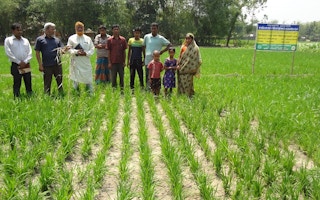Boro rice, once the dominant form of paddy grown in Bangladesh, is increasingly under strain due to the high level of irrigation it uses. Most of the popular varieties of Boro rice were developed by the Bangladesh Rice Research Institute (BRRI), and were meant to deal with cultivation in waterlogged areas. In this they succeeded wildly, and are planted in Bangladesh, India and parts of Nepal. It is the largest paddy in terms of production in Bangladesh, and produced approximately 19 million metric tonnes in the year 2013-14 out of a total of 34.5 tonnes.
Nevertheless with rising water stress, and erratic weather, the Bangladesh government has been trying to reduce the Boro paddy cultivation in the country for last few years. Boro paddy by natural cultivation methods requires about 3,500 litres of water to produce one kilogramme of rice.
In the traditional method farmers prepare their land in the middle of December to grow seedlings in the seedbed. It takes around 45 days to prepare the seedlings for sowing in the clay field.
During the seedling phase the crop is standing in water, which was ideal when fields were waterlogged, but is not so now as water usage has increased significantly in urban areas, and groundwater levels have been falling for decades.
So now Boro rice, the mainstay of agriculture, competes for scarce water. Production levels remain very high, though they have dipped a little in recent years due to lower procurement prices from the government.
“
This was a totally different practice but the production was almost same. It requires less water which ultimately reduces the overall production cost.
Anwarul Islam, farmer, Dinajpur, northern Bangladesh
A new method
In this bleak situation, scientists from the Bangladesh Agricultural University (BAU) have developed an alternative Boro paddy cultivation method that may save the day. This ‘dry method’ requires only half the water needed by the traditional ‘clay method’.
Moshiur Rahman, an agronomy professor at BAU who led the research into the new method, said, “It reduces the amount of water used by around 50 per cent”.
The researchers have dubbed the new method “dry direct seeded Boro rice production technology”. In this new method, the seedling process is bypassed, saving on both time and water.
Instead the seeds have to be soaked for 24 hours before sowing, and the distance between the seeds kept at 15 centimetres, and the distance between lines of seeds at 25 centimetres, like in wheat planting. By avoiding the seedling stage, this process reduces the water demand by about 35 per cent, while another 15 per cent is saved because the new method will no longer require 15 days of standing water in the fields.
In both cases, the paddy requires water in the field for 30 days between panicle initiation, just after the stem stops growing in length, and the grain filling stages. In the dry process, the seed needs to be planted directly at the end of January and take around 105 to 115 days to be harvested, while the clay method takes 95 days after sowing the seedlings.
The research
Lead researcher Moshiur Rahman started working on the project in 2006 in a field that was part of the laboratory space in his university. It took him two years to achieve the first successful harvest. Then he started testing in the field. Rahman has been demonstrating his dry direct Boro paddy cultivation technology in the districts of Rajshahi, Rangpur, Dinajpur, Tangail and Netrokona since 2009.
Although the tests have been largely successful the new method does have its problems. The traditional method leads to harvesting a little earlier than the dry method, making the fields of the latter vulnerable to pests. The farmers cannot shift their planting earlier to compensate because the temperature would be too low for the seedlings. Nevertheless, Rahman suggested that if farmers adopted the method en masse then the pest problem would also go away.
Anwarul Islam, a farmer from the district of Dinajpur in northern Bangladesh, applied the ‘dry method’ of boro cultivation on his field of one and a half acres last year. “This was a totally different practice but the production was almost same,” he told thethirdpole.net. “It requires less water which ultimately reduces the overall production cost.”
The water from adjacent fields – which were using the traditional methods – leaked into his fields, though, creating problems for him.
The government of Bangladesh has invited Rahman to demonstrate the method. Jibon Krisna Biswas, director general of BRRI, told thethirdpole.net, “The new method is ground breaking. I have personally [assessed] the invention and I believe that it will work in reducing water use in the country’s Boro paddy cultivation remarkably.”
But for it to succeed, farmers need to be informed and helped to implement the new method successfully.
This story is published with permission from The Third Pole.










